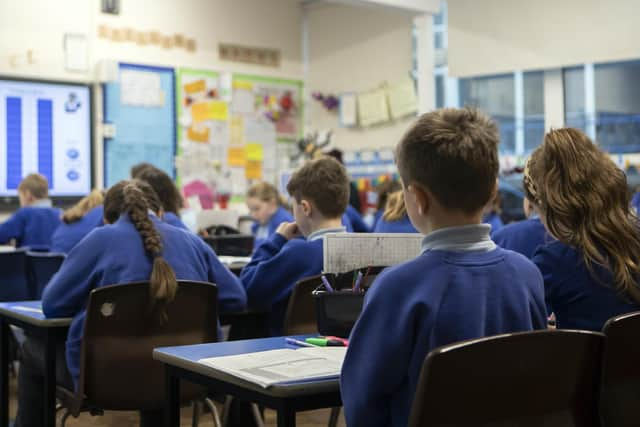Scottish Government urged to act on schools 'crisis' amid sharp fall in teacher numbers in key subjects
The Scottish Government has been warned it is presiding over a “crisis” in schools after it emerged the number of secondary teachers in key subjects has fallen significantly since the SNP came to power.
Liberal Democrat education spokesman Willie Rennie said it was “extremely troubling” to see declines in the number of teachers in maths, physics, computing and technical education.
Advertisement
Hide AdAdvertisement
Hide AdHe called for action to end a “vicious cycle” he said was undermining recruitment and retention, including a lack of stable contracts.


Recent statistics reveal there were now 1,067 fewer full-time equivalent teachers in all subjects and specialisms in Scotland than there were in 2007, as well as 273 fewer schools.
The numbers have been shrinking despite the overall pupil roll rising by more than 13,000 youngsters in the same period.
Now the Scottish Lib Dems have highlighted a downturn in the number of teachers for STEM (science, technology, engineering, and mathematics) subjects, which are viewed as vital for the economy.
An analysis of the figures found the number of computing studies teachers in secondary schools has fallen by a quarter from 766 in 2008 to 578 in 2023.
Meanwhile, the number of maths teachers was down by nearly 12 per cent in the period, there was an 11 per cent decline in technical education, and an 8 per cent decrease in physics teachers.
Mr Rennie said: “It’s extremely troubling to see such a sharp decline in STEM subject teachers.
“These subjects open the doors to industries of the future but with so few teachers now specialising in them and no sign of action to encourage more teachers into the workforce, the SNP are creating a vicious cycle that diminishes the skills of future generations and undermines teacher recruitment for years to come.
Advertisement
Hide AdAdvertisement
Hide Ad"Scottish Liberal Democrats want to end this crisis, and that’s why we would bring back principal teachers for every STEM subject, giving young people better access to these subjects, and guarantee teachers stable contracts they can depend on.”
The SNP pledged to recruit 3,500 additional teachers and classroom assistants in 2021 but the overall numbers have now fallen in the last two years.
Education Secretary Jenny Gilruth announced in December that maths would be a "central focus" of a revamped curriculum, with the work to be led by a maths specialist.
It followed widespread concern at the long-term decline in Scotland’s performance in maths, science and reading in the OECD’s Pisa rankings.
The data on teacher numbers show even bigger drops in some other subjects, such as French, where the number was down by almost 43 per cent in the period, while the number of German teachers had declined by almost 59 per cent.
On the other hand, the numbers were higher than in 2008 in several subjects, such as PE, music, modern studies, Spanish and history.
Despite the reduction in some STEM subjects, the figures also show that there was a 16 per cent increase in the number of biology teachers in the period, and a 9 per cent rise in general science. The number of chemistry teachers was the same, at 989.
Overall, there had been a 3.65 per cent reduction in the number of full time equivalent secondary teachers between 2008 and 2023.
Advertisement
Hide AdAdvertisement
Hide AdThe figures emerged just two weeks after The Scotsman revealed huge shortfalls in the number of students studying to become teachers in these key subjects.
Just 1,002 graduates enrolled in Professional Graduate Diploma in Education (PGDE) courses for secondary teaching in 2023, which was only very slightly more than half the target of 2,000.
Only 83 students were studying to be maths teachers via a PGDE, against a target of 250, while in English it was 127 out of 248. In modern languages, the intake was of 46 against a target of 138, and in technical education it was 26 out of 81.
Chemistry had attracted 54 students from a target of 159, while computing was 16 out of 52, music was 19 out of 54, and physics was 38 out of 131. PE was the only subject to meet its target.
Including undergraduates, a total of 1,241 students were studying to be secondary teachers, against a target of 2,336.
The picture is different in the primary sector, with 1,803 people enrolling in courses, more than the target of 1,734. In total, looking at both primary and secondary, the student teacher intake was 3,044, out of a target of 4,070.
Minutes from a meeting of the Government’s Teacher Workforce Planning Advisory Group showed how the trends were discussed.
The group said consideration was needed on “how the system will cope with less graduates and if this will result in significant structural changes”. It added that a “longitudinal review of secondary subject recruitment” was needed to “identify consequences for schools”
Advertisement
Hide AdAdvertisement
Hide AdA Scottish Government spokesperson said: “Local authorities are responsible for the recruitment and deployment of teaching staff.
"The Scottish Government will continue to support them to maximise the number of jobs available in certain subjects, including STEM.
"Since 2008, there have been increases in the number of teachers in biology and general science.
“Our Teaching Bursary Scheme is offering a £20,000 payment to career changers who are looking to undertake graduate teacher training in hard-to-fill STEM subjects – including physics, maths, technical education and computing science.
“We are also providing local authorities with £145.5 million in this year’s budget to protect teacher numbers more widely.”
Comments
Want to join the conversation? Please or to comment on this article.
